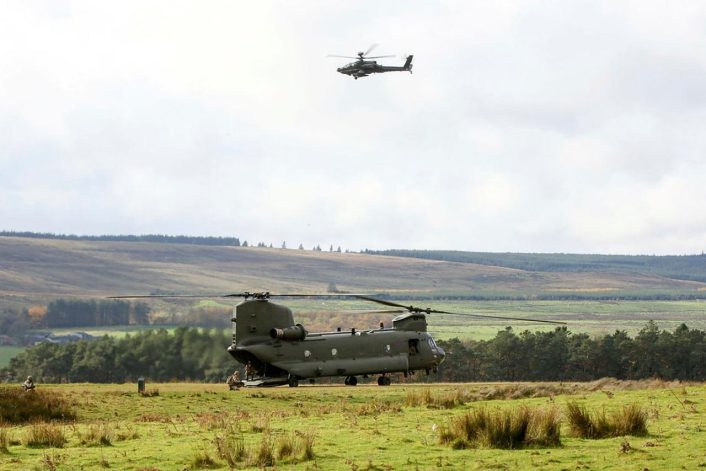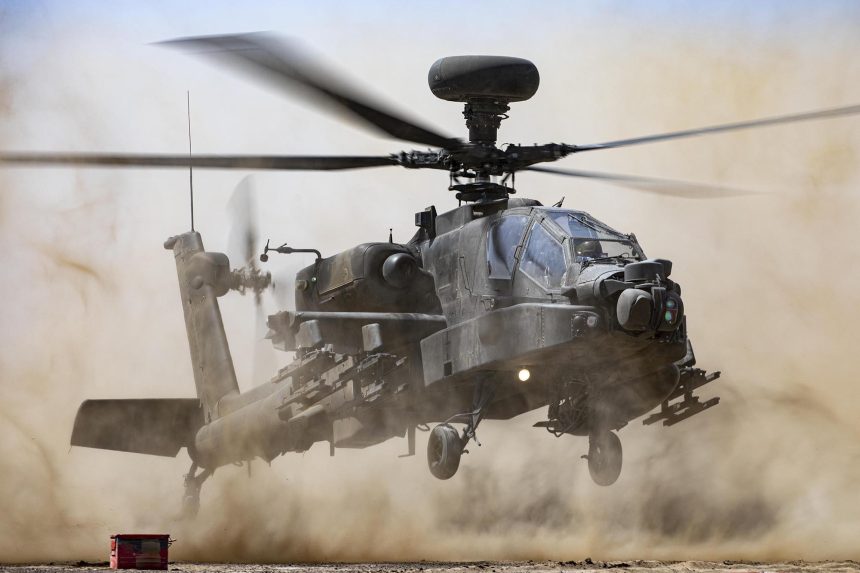A newly released report has revealed a 2016 incident where two soldiers were discovered naked from the waist down inside the cockpit of a parked Apache helicopter.
During an exercise at the Otterburn Training Area in Northumberland, England, ground crews assigned to support the detachment of Apache AH1 helicopters from 653 Squadron AAC were preparing to fit weather protection covers to their aircraft when they noticed the rotors were moving up and down, along with strange noises.
Investigating further, they found a male and a female soldier from a different unit inside the helicopter. The report details: “It became apparent that the rear cockpit was occupied by two people engaged in sexual intercourse. Both were naked from the waist down — the male in uniform, the female in civilian attire. They were ordered to exit the cockpit and get dressed. Both parties were serving soldiers. Both showed symptoms of intoxication.”
The two individuals were subsequently detained pending the arrival of superior officers from their unit. What happened to the soldiers after this is unclear.
New guidelines were reportedly introduced following the incident requiring crews to more stringently secure their aircraft when unattended. While there are already procedures for this when leaving aircraft in less secure areas, it is likely that the rules were previously more relaxed when parked in controlled areas like an active military training range.
British newspapers reported on the incident, which came to light thanks to a Military Aviation Authority safety report revealed due to a computer glitch.

The Apache entered British service in 2001, with full operational status being declared in 2005. Designated the Apache AH1, the Army Air Corps’ Apaches were unique, having been assembled by AgustaWestland in the UK and fitted with a folding rotor mechanism and the same Rolls-Royce Turbomeca RTM322 engines used by the AW101 Merlin.
Otherwise roughly equivalent in specification to the AH-64D standard, AgustaWestland internally designated the model WAH-64D – W for Westland. This followed a similar practice to previous license-built designs like the Sikorsky S-58 and S-61 Sea King helicopters, whose Westland derivatives were sometimes known by the designations WS-58 and WS-61.
In 2024 the final Apache AH1 was retired in favor of the AH-64E Apache Guardian. Fifty Apache AH1s were sent to the United States in order to be stripped down so a number of parts could be reused in the build process of these new airframes. Though sometimes referred to as the Apache AH2, the helicopter has not actually received this British style designation, instead keeping its U.S.-assigned name in British service, much like the RC-135 Rivet Joint and C-17 Globemaster III.
Today the Army Air Corps says goodbye to the Mk1 Apache as it reaches its out of service date, with it’s replacement, the Apache E Model, bringing new technology and capability to the future
Photographed from a Wildcat@ArmyAirCorps @BritishArmy @4RegimentAAC @aacrecruiting pic.twitter.com/KUYJTD8jCQ
— 1 Regt AAC (@1_Regt_AAC) March 25, 2024
Wider issues in the services
While this is, seemingly, the first public incident of this kind involving an Apache helicopter, tales of promiscuity, drunkenness, and bawdy behavior among UK forces is a common theme in British newspapers.
In 2019, a group of serving Royal Navy personnel from RNAS Culdrose were placed under investigation following sexually explicit behavior at a pub in the adjoining town of Helston. The year prior, six sailors were arrested in Florida during a ‘run ashore’ while the carrier strike group of HMS Queen Elizabeth was making a port call.
Though cases of consensual intimacy, though in inappropriate fashions, and drunken partying often make the news, more seriously there are also long-standing reports of predatory behavior, sexual harassment, and misogyny within all branches of the armed forces.
A 2022 report revealed an affair between two officers of the Royal Navy Submarine Service led to the insecure dissemination of classified information. Sophie Brook, who was formally dismissed from the Royal Navy due to the incident, was the first female volunteer for submarine duty in the Royal Navy. She has since gone on record to reveal that she was the victim of aggressive sexual harassment from several individuals within the Submarine Service. Last month, The Guardian reported on the findings of an inquiry which confirmed her claims, leading to the dismissal of at least three personnel and an official apology from First Sea Lord Admiral Sir Ben Key.
In the Royal Air Force, high profile investigations revealed a culture of misogyny within the Royal Air Force Aerobatic Team, more famously known as The Red Arrows. Two pilots from the team were dismissed, while five other members of the squadron received disciplinary action.
🔺 EXCLUSIVE: Members of the Red Arrows have been accused of bullying, misogyny, assault, sexual harassment and drunkenness in the biggest scandal in the team’s 60-year history https://t.co/8xNioTUXF3
— The Times and The Sunday Times (@thetimes) August 23, 2022
A wide-reaching government inquiry into the experiences of women serving in the British military heard evidence from over 4,000 serving female personnel and veterans. Their testimonies revealed widespread sexual abuse, harassment and general discrimination, often without any fear of retribution.
With well-known recruitment and personnel retention issues across all branches, the Ministry of Defence understandably places improving the workplace culture within the forces at a high priority. Removing these established cultures, though, can be a very long and difficult process.









